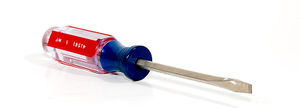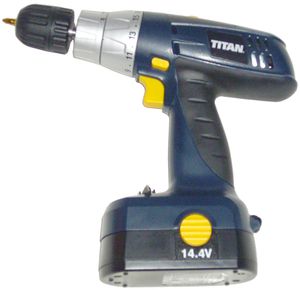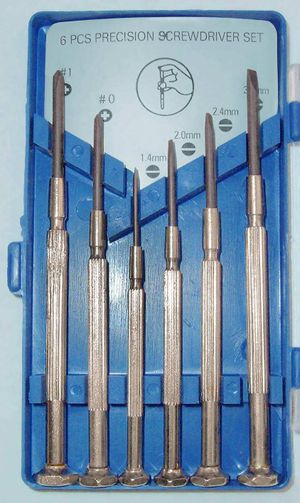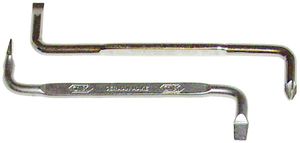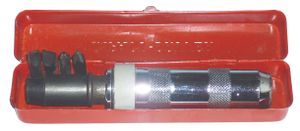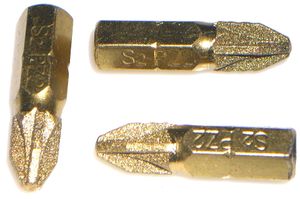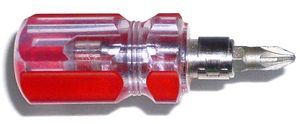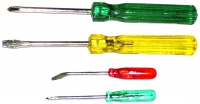Difference between revisions of "Screwdriver"
(→Screwdriver forms: pic insulated one) |
(pics) |
||
| (21 intermediate revisions by the same user not shown) | |||
| Line 1: | Line 1: | ||
| − | |||
[[image:800px-Screw_Driver_display.jpg|thumb|Traditional manual screwdriver]] | [[image:800px-Screw_Driver_display.jpg|thumb|Traditional manual screwdriver]] | ||
| + | [[image:Screwdriver hex ylo 402-4.jpg|thumb|hex bit handle]] | ||
[[image:ElectricScrewdriver.jpg|thumb|Low power electric screwdriver]] | [[image:ElectricScrewdriver.jpg|thumb|Low power electric screwdriver]] | ||
| − | [[image: | + | [[image:Cordless drill 1642-4.jpg|thumb|Cordless drill/driver]] |
[[image:Ratchetscrewdriver.jpg|thumb|Stubby ratchet screwdriver]] | [[image:Ratchetscrewdriver.jpg|thumb|Stubby ratchet screwdriver]] | ||
[[image:Spiral-screwdriver.jpg|thumb|Push drive Yankee]] | [[image:Spiral-screwdriver.jpg|thumb|Push drive Yankee]] | ||
[[image:Jeweller's-screwdriver-set.jpg|thumb|Jeweller's screwdrivers]] | [[image:Jeweller's-screwdriver-set.jpg|thumb|Jeweller's screwdrivers]] | ||
| − | [[image:Electrical screwdriver 143- | + | [[image:Electrical screwdriver 143-3.jpg|thumb|Electrician's screwdriver]] |
| + | [[image:Cranked screwdrivers 0081-6.jpg|thumb|Cranked screwdriver]] | ||
| + | [[image:Impact driver 2507-3.jpg|thumb|Manual impact driver]] | ||
| + | [[image:Diamond bits PZ2 2111-5.jpg|thumb|Bits]] | ||
| + | [[image:Stubby screwdriver 2612-4.jpg|thumb|stubby hex bit handle]] | ||
| + | ==Screwdriver forms== | ||
Screwdrivers come in jeweller's, stubby, small, medium, large and oh my god what are you going to do with that sizes. | Screwdrivers come in jeweller's, stubby, small, medium, large and oh my god what are you going to do with that sizes. | ||
Screwdrivers can be traditional one piece tools, or hold replaceable [[hex bits]]. | Screwdrivers can be traditional one piece tools, or hold replaceable [[hex bits]]. | ||
| − | Screwdrivers can be manual or electrically powered. There are also push | + | Screwdrivers can be manual or electrically powered. There are also push operated spiral screwdrivers such as the Yankee, but these are rarely used today. |
| − | + | Screwdrivers come in 90 degree cranked (bent) form for where access is difficult. | |
| − | They come in pound-through form where | + | They come in pound-through form where [[hammer]]ing is needed. These have the metal shank continuing all the way through the handle so it can be hit directly. |
| − | When access is too tight to use a cranked or stubby driver, a short [[hex bits|bit]] plus pliers | + | When access is too tight to use a cranked or stubby driver, a short [[hex bits|bit]] plus pliers sometimes works. |
| − | Extra large screwdrivers are quite useful, but | + | Extra large screwdrivers are quite useful, but attract rude comments and strange stares on site. They position the hands well away from cramped corners and abrasive walls, they allow driving without needing to get close to the workpiece, and they sometimes allow a better working position, making application of force easier. In cramped conditions they can also allow workmates to pass between you and the [[screws]] while you're working, which is a mixed blessing. They are also good when one is forced to work in an awkward position, as a bit of hand movement or wobble has little effect on screwdriver angle. |
| − | Impact drivers are a special type of screwdriver that turns when hit with a hammer. These give the ultimate in screwing and unscrewing power. The name '[[Impact driver]]' is also used for power tools that do a similar but not identical job. | + | Impact drivers are a special type of screwdriver that turns when hit with a hammer. These give the ultimate in screwing and [[screws|unscrewing]] power. The name '[[Impact driver]]' is also used for power tools that do a similar but not identical job. |
| − | Both screwdrivers and [[Hex bits|bits]] are available with diamond coating. | + | Both traditional screwdrivers and [[Hex bits|bits]] are available with diamond coating. They grip the screw head better, so higher force can be applied without the bit jumping out. |
[[Electric screwdrivers]] are covered in their own article. | [[Electric screwdrivers]] are covered in their own article. | ||
| + | |||
==Bits== | ==Bits== | ||
1/4" [[hex bits|hex screwdriving bits]] come in short 1", medium 2" and long 6" forms. | 1/4" [[hex bits|hex screwdriving bits]] come in short 1", medium 2" and long 6" forms. | ||
| − | [[Hex bits]] are covered fully in their | + | [[Hex bits]] are covered fully in their [[Hex bits|own article]]. |
| Line 37: | Line 43: | ||
===Blade=== | ===Blade=== | ||
Screwdrivers are made from either chrome vanadium steel or carbon steel. | Screwdrivers are made from either chrome vanadium steel or carbon steel. | ||
| + | |||
====Chrome vanadium==== | ====Chrome vanadium==== | ||
This is the softer of the two, and the bits are liable to become damaged over time. Most screwdrivers today are chrome van. | This is the softer of the two, and the bits are liable to become damaged over time. Most screwdrivers today are chrome van. | ||
| + | |||
====Carbon steel==== | ====Carbon steel==== | ||
Harder, lasts longer, and performs better. However it has its downsides. | Harder, lasts longer, and performs better. However it has its downsides. | ||
* It rusts readily, hence its often chrome coated. Chrome is a relatively slippery coating, and not wanted for screwdriving. | * It rusts readily, hence its often chrome coated. Chrome is a relatively slippery coating, and not wanted for screwdriving. | ||
| − | * Being harder, carbon steel can eventually break rather than chew up. Harder steel is also not | + | * Being harder, carbon steel can eventually break rather than chew up. Harder steel is also not as tolerant of misuse, eg use as a mini prybar. |
Most screwdrivers today are chrome vanadium, perhaps because minimising failures is more useful to the manufacturer than maximising performance. If you want the better performance of correctly hardened and tempered carbon steel, Draper, Tough-Tools and Stanley still sell them. | Most screwdrivers today are chrome vanadium, perhaps because minimising failures is more useful to the manufacturer than maximising performance. If you want the better performance of correctly hardened and tempered carbon steel, Draper, Tough-Tools and Stanley still sell them. | ||
| + | |||
===Handle=== | ===Handle=== | ||
| Line 53: | Line 62: | ||
There are many handle shapes available, with large oval cabinet maker handles being one of the more comfortable. | There are many handle shapes available, with large oval cabinet maker handles being one of the more comfortable. | ||
| − | Most significant is the size of the handle. The bigger the | + | Most significant is the size of the handle. The bigger the width, the more leverage advantage is obtained, making application of high forces easier. Switching from a small to a big handle can make a challenging [[screws|screw]] easy. |
For electrical connections high forces are not normally needed, and slender handles enable quicker spinning of the tool. | For electrical connections high forces are not normally needed, and slender handles enable quicker spinning of the tool. | ||
| Line 59: | Line 68: | ||
==Electrical Screwdrivers== | ==Electrical Screwdrivers== | ||
| + | [[image:Screwdriver elec vs mech 2493-7.jpg|right|200px]] | ||
| + | |||
| + | Screwdrivers intended for electrical work differ in some details from traditional drivers. | ||
| + | |||
| + | |||
===Shank=== | ===Shank=== | ||
| − | Electrical Screwdrivers with a fully sleeved shank are available. These reduce the remote risk of all the following happening at once: the wiring being live, touching the screwdriver shank during work, and being sufficiently well earthed for serious harm to occur. | + | Electrical Screwdrivers with a fully sleeved shank are available. These reduce the remote risk of all the following happening at once: the wiring being live, touching the screwdriver shank during work, and being sufficiently well [[Earthing Types|earthed]] for serious harm to occur. |
| − | Good quality drivers are tested to 10kV. Cheap imitations may be rated 1kV and not tested | + | Good quality drivers are tested to 10kV. Cheap imitations may be rated 1kV and not tested. Both are an improvement over bare shanks, although the safety advantage of an insulated shank is usually small. |
| − | The exception is with live working, where an insulated shank is a very good idea. | + | The exception is with live working, where an insulated shank is a very good idea. Few DIYers work live though. |
===Bit=== | ===Bit=== | ||
| − | + | Traditional screwdrivers widen where the metal is flattened to make the bit, but electrical work screwdrivers don't, making them better suited to work in recessed access holes. | |
==Junk screwdrivers== | ==Junk screwdrivers== | ||
| − | These are generally small with narrow plastic handles, giving poor driving force and being hard on hands. The worst ones have a soft steel bit, making them bend readily. Occasionally a tiny one can get in places others won't. Cross head types may fail to fit the | + | [[image:Small screwdrivers 415-5.jpg|right|200px]] |
| + | |||
| + | These are generally small with narrow plastic handles, giving poor driving force and being hard on hands. The worst ones have a soft steel bit, making them bend readily. Occasionally a tiny one can get in places others won't. Cross head types may fail to fit the [[screw]]head. | ||
| + | |||
| + | Rarely one can be bent to get to a particularly difficultly positioned [[screw]]. | ||
| + | |||
==Electronic adjustment== | ==Electronic adjustment== | ||
| − | Jeweller's screwdrivers are sometimes used to adjust settings in electronic equipment. | + | Jeweller's screwdrivers are sometimes used to adjust settings in electronic equipment. Sometimes these are ok, but often not. |
| + | |||
| + | Metal tools can shock the user, or affect the operation of high impedance and low level circuits, so should be used with some caution. | ||
| + | |||
| + | Metal tools also affect the tuning of rf circuitry when they're inserted, so the tuning changes again when they're removed. This makes proper adjustment of rf circuits very difficult. All-plastic tools are available for this, making the task more practical. Plastic tools are no use for screwdriving of course. | ||
| + | |||
==Neon screwdrivers== | ==Neon screwdrivers== | ||
| − | + | [[Neon screwdriver]]s are criticised on safety grounds and not recommended by uk.d-i-y regulars. Their use at work is illegal. | |
| + | |||
==See Also== | ==See Also== | ||
| Line 85: | Line 110: | ||
* [[Special:Allpages|Wiki Contents]] | * [[Special:Allpages|Wiki Contents]] | ||
* [[Special:Categories|Wiki Subject Categories]] | * [[Special:Categories|Wiki Subject Categories]] | ||
| + | * [[http://thereifixedit.com/2010/01/02/screw-tool-safety/ Uhoh]] | ||
[[Category:Tools]] | [[Category:Tools]] | ||
| + | [[Category:Basics]] | ||
Latest revision as of 20:01, 30 April 2012
Screwdriver forms
Screwdrivers come in jeweller's, stubby, small, medium, large and oh my god what are you going to do with that sizes.
Screwdrivers can be traditional one piece tools, or hold replaceable hex bits.
Screwdrivers can be manual or electrically powered. There are also push operated spiral screwdrivers such as the Yankee, but these are rarely used today.
Screwdrivers come in 90 degree cranked (bent) form for where access is difficult.
They come in pound-through form where hammering is needed. These have the metal shank continuing all the way through the handle so it can be hit directly.
When access is too tight to use a cranked or stubby driver, a short bit plus pliers sometimes works.
Extra large screwdrivers are quite useful, but attract rude comments and strange stares on site. They position the hands well away from cramped corners and abrasive walls, they allow driving without needing to get close to the workpiece, and they sometimes allow a better working position, making application of force easier. In cramped conditions they can also allow workmates to pass between you and the screws while you're working, which is a mixed blessing. They are also good when one is forced to work in an awkward position, as a bit of hand movement or wobble has little effect on screwdriver angle.
Impact drivers are a special type of screwdriver that turns when hit with a hammer. These give the ultimate in screwing and unscrewing power. The name 'Impact driver' is also used for power tools that do a similar but not identical job.
Both traditional screwdrivers and bits are available with diamond coating. They grip the screw head better, so higher force can be applied without the bit jumping out.
Electric screwdrivers are covered in their own article.
Bits
1/4" hex screwdriving bits come in short 1", medium 2" and long 6" forms.
Hex bits are covered fully in their own article.
Screwdriver materials
Blade
Screwdrivers are made from either chrome vanadium steel or carbon steel.
Chrome vanadium
This is the softer of the two, and the bits are liable to become damaged over time. Most screwdrivers today are chrome van.
Carbon steel
Harder, lasts longer, and performs better. However it has its downsides.
- It rusts readily, hence its often chrome coated. Chrome is a relatively slippery coating, and not wanted for screwdriving.
- Being harder, carbon steel can eventually break rather than chew up. Harder steel is also not as tolerant of misuse, eg use as a mini prybar.
Most screwdrivers today are chrome vanadium, perhaps because minimising failures is more useful to the manufacturer than maximising performance. If you want the better performance of correctly hardened and tempered carbon steel, Draper, Tough-Tools and Stanley still sell them.
Handle
Handles come in wood, plastic or rubber. Wood and plastic handles have little to choose between them, except that plastic is available in a wider range of shapes. Rubber handles help maximise grip.
There are many handle shapes available, with large oval cabinet maker handles being one of the more comfortable.
Most significant is the size of the handle. The bigger the width, the more leverage advantage is obtained, making application of high forces easier. Switching from a small to a big handle can make a challenging screw easy.
For electrical connections high forces are not normally needed, and slender handles enable quicker spinning of the tool.
Electrical Screwdrivers
Screwdrivers intended for electrical work differ in some details from traditional drivers.
Shank
Electrical Screwdrivers with a fully sleeved shank are available. These reduce the remote risk of all the following happening at once: the wiring being live, touching the screwdriver shank during work, and being sufficiently well earthed for serious harm to occur.
Good quality drivers are tested to 10kV. Cheap imitations may be rated 1kV and not tested. Both are an improvement over bare shanks, although the safety advantage of an insulated shank is usually small.
The exception is with live working, where an insulated shank is a very good idea. Few DIYers work live though.
Bit
Traditional screwdrivers widen where the metal is flattened to make the bit, but electrical work screwdrivers don't, making them better suited to work in recessed access holes.
Junk screwdrivers
These are generally small with narrow plastic handles, giving poor driving force and being hard on hands. The worst ones have a soft steel bit, making them bend readily. Occasionally a tiny one can get in places others won't. Cross head types may fail to fit the screwhead.
Rarely one can be bent to get to a particularly difficultly positioned screw.
Electronic adjustment
Jeweller's screwdrivers are sometimes used to adjust settings in electronic equipment. Sometimes these are ok, but often not.
Metal tools can shock the user, or affect the operation of high impedance and low level circuits, so should be used with some caution.
Metal tools also affect the tuning of rf circuitry when they're inserted, so the tuning changes again when they're removed. This makes proper adjustment of rf circuits very difficult. All-plastic tools are available for this, making the task more practical. Plastic tools are no use for screwdriving of course.
Neon screwdrivers
Neon screwdrivers are criticised on safety grounds and not recommended by uk.d-i-y regulars. Their use at work is illegal.
